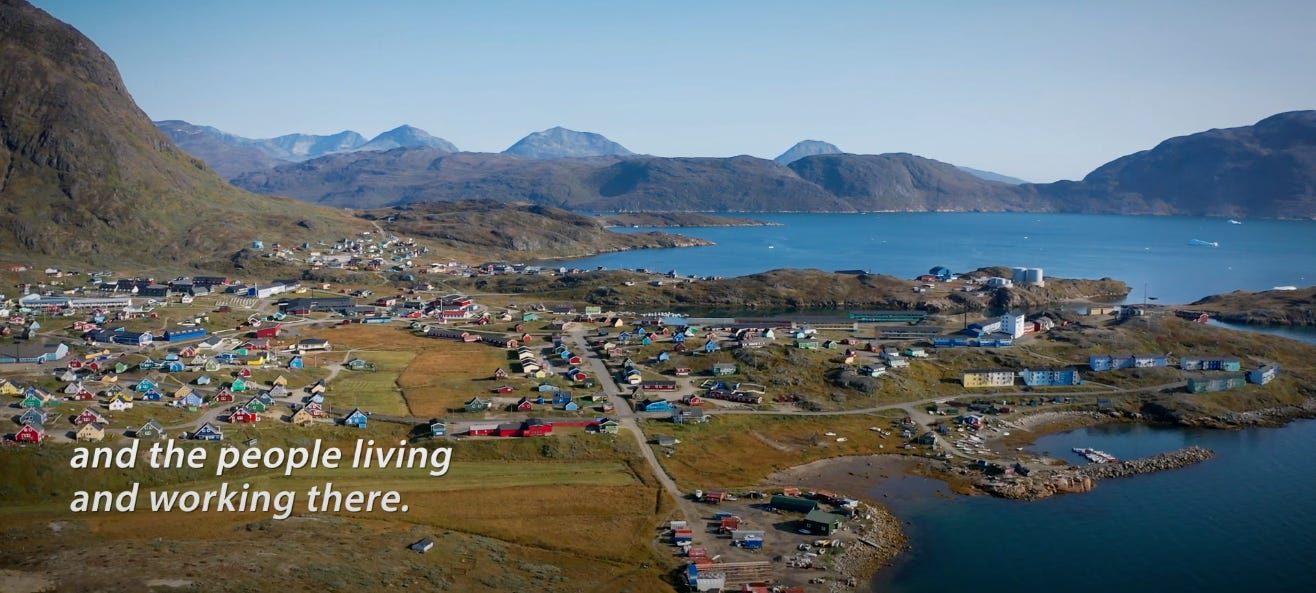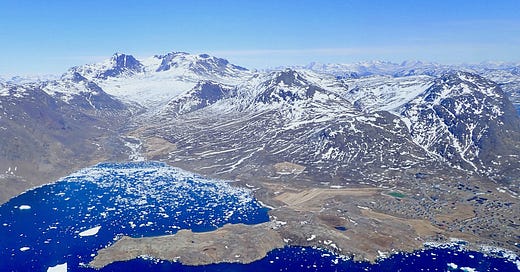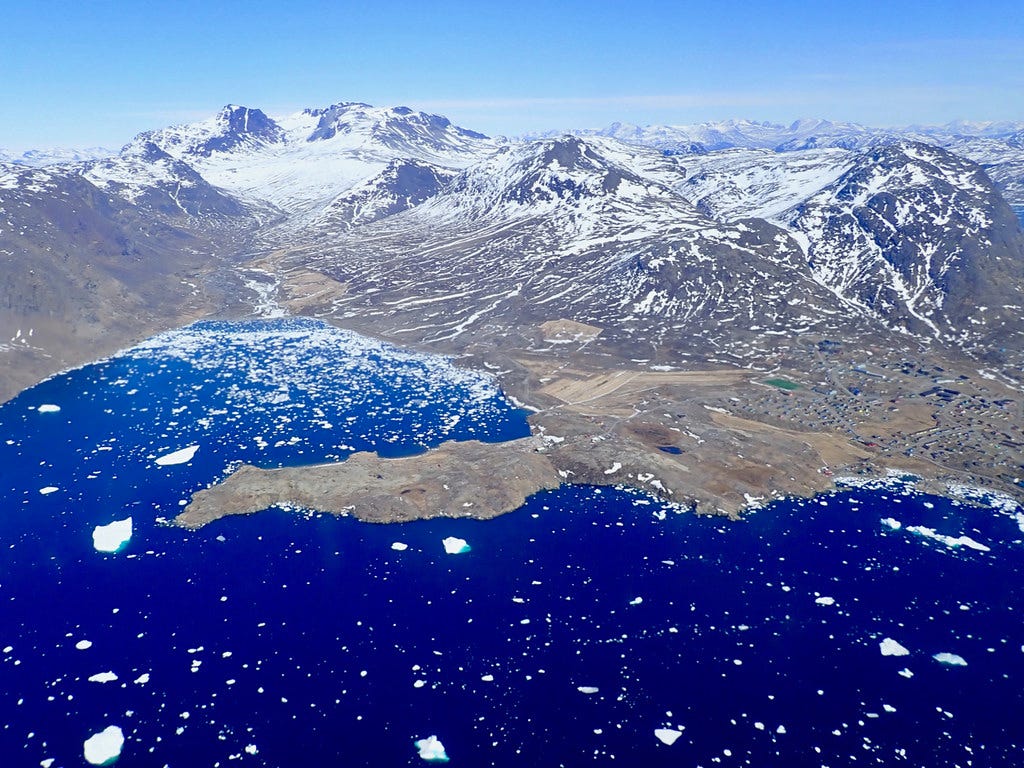Greenland is set to oust a rare earths mine that's in the crosshairs of global industries
Also: what does reporting on this small town suggest about who should determine whether mining happens?
Climate technologies require enormous amounts of metal. I’m Ian Morse, and this is Green Rocks, a newsletter that doesn’t want dirty mining to ruin clean energy.
Greenland, a land of 56,000 people whose ice sheet is an epitome of climate crisis catastrophe, saw its government collapse in February amid political fights over a mine that touts itself as the solution to rising temperatures. The proposed mining project would extract uranium and rare earth elements that are used for wind turbines.
On Tuesday, the government held a snap election to reconfigure parliament. For Mariane Paviasen, the election was like a referendum on the mine.
“This is a big question,” Paviasen told me. “Should Greenland be a nation that is selling uranium and rare earths? Or should Greenland try to remain one of the cleanest countries in the world?”
The results of the election already have people saying the mine has been “laid in its grave.”
Paviasen’s party, Inuit Ataqatigiit (IA), staunchly opposed the mine, and it emerged victorious with the most seats in parliament. Without a majority, the IA will head up a coalition government. First on its to-do list is to refuse to grant the mine its permits.
Paviasen’s own political career is emblematic of the transition Greenland has seen over the past year. Paviasen left her job on the helipad to begin an organization that spreads awareness of the proposed uranium mine in her hometown of Narsaq. Dismayed by a lack of transparency, she ran for elected representative. Tuesday’s election solidified her role has her hometown’s voice in parliament.
“We don’t have to open mines polluting every corner of our mother earth. We have to think in a cleaner way and think of our next generations, that we are not the only generation here in the earth,” Paviasen said when we spoke a few weeks ago.

The mining company, Australia-based Greenland Minerals, has already spent upwards of $300 million in preparing the project. That’s 10% of Greenland’s GDP. They said in a statement on Facebook: “Greenland Minerals congratulates everyone on the election. We look forward to a good collaboration with the new parliament and the upcoming government.”
The project is not over yet. The government still must make the rejection official, and Greenland Minerals has said that they hope everything will happen in accordance with the law.
The mining project has been wrapped up in Greenland’s ambitions to raise incomes and to become independent from Denmark, which owns the island. The election and its ramifications will likely determine how it balances global geopolitics and Indigenous ways of life. As its citizens have wrestled with warming oceans and non-western futures, it has found itself in the crosshairs of planetary grasps for minerals.
Greenland Minerals calls the project Kvanefjeld, but locals know it as Kuannersuit. Paviasen learned of the project as a uranium mine that began exploration several decades ago, when Greenland was imagined as a fuel source for the other countries’ nuclear energy ambitions. But in 1988, the country banned uranium mining.
In 2013, that ban was lifted in a narrow vote overshadowed by the Kuannersuit project. That year, Paviasen launched No To Uranium, an organization that spread awareness of the potential impacts of uranium mining. Her main concern was that the government had lifted the ban without properly informing citizens. And recently, as the project edged closer to full approval, the lack of transparency still worried Paviasen.

“The problem is they never informed us about pollution,” she says. Most information is published in English or Danish, and there is little in Greenlandic, the national language. It’s hard just to find translation software for Greenlandic online. For Paviasen, English was a requirement in her uranium advocacy and research, and she has been mostly teaching herself since 2013. Using Facebook, she gradually became a source of information not only for the town of Narsaq, but also for others in Greenland. Joining parliament, she believed, would make it easier to ensure even those without internet could understand why the country banned uranium mining before, and what the risks are in restarting it.
Concerns with uranium mining typically center on the risk of introducing high radiation levels outside the project site. Some locals believe radioactive dust may travel the 7 kilometers to the town or elsewhere, although that claim is disputed. The company has said it would cover piles of waste with water so wind cannot pick it up. In the winter though, that water may freeze. Mixing tailings with water may also increase the potential for leakages to affect groundwater and rivers. Other minerals will also be opened to the elements and could leach into rivers. Coastal water contamination may threaten Narsaq’s bustling fish industry.
In addition, the company’s environmental assessment calculates that the project would spike Greenland’s CO2 emissions by 45%, according to a Friends of the Earth Denmark report in February.

The Kuannersuit project will mostly extract rare earths, including neodymium which is used in wind turbines and combat aircraft. Greenland Minerals’ marketing centers on the the clean energy promise, although the neodymium may be fed into military industries as well.
Proponents of the project, as well as Greenland Minerals, believe the rare earth mine is the answer to the country’s economic development that has lagged behind richer countries. The risks of mining can be mitigated, and the 300 local jobs would benefit local wealth, the company says. (It hasn’t responded to a request for comment.)
Paviasen believes there are other options for boosting the country’s economy. The country’s minerals may be the most valuable, but they are only calculated to last 37 years. Narsaq is also home to a brewery, fish processors, a salt factory, as well as the only culinary college and the only slaughterhouse in the country. Much of the country’s food is imported from Denmark.
“It is possible to have agriculture here in south Greenland, and I don’t understand why we haven’t developed those things,” says Paviasen. “[The country] can be more independent with mines, but they don’t need to start with that.”
Many people in Narsaq have said that they will move away if the company is granted the operating license, Paviasen says. That would be difficult for the town’s 1400 citizens, many of whom haven’t lived anywhere else before. From her home in Narsaq, Paviasen questions why companies feel they need to damage part of Greenland for clean energy aims.
“I don’t know how we can call then clean energies by destroying a landscape like Greenland and ship those minerals to the other side of the world,” she says. Recycling, she says, must be the solution. However, rare earths are not often recycled, and increasing demand for wind turbines may not be able to cover the required neodymium.
How the Greenland story has been reported
Lack of information for locals has stood in sharp contrast with a vibrant debate in global geopolitics.
“There’s been much media interest, but there has been a lack of information here in Greenland,” Paviasen says. The company’s website says it strives for transparency. After the news of IA’s win in parliament, news outlets again trained their focus on international business.
“What this type of coverage does (and it’s pretty ubiquitous in English-language coverage) is situate Greenland’s struggles for self-determination as a sort of bump in the road on the way to whatever futures global businesses have outlined,” says Zane Griffin Talley Cooper, a PhD candidate at the University of Pennsylvania, who studies resource extraction in the Arctic.
Siumut, the party that has been in power almost consistently since 1979, adopted the argument of Greenland Minerals. A robust mining industry would give Greenland the strength needed to become independent from Denmark. The IA doesn’t necessarily disagree. The only position the party has held consistently is that it does not want to support uranium mining. Another project aims to mine rare earths (not the same ones) without uranium near Narsaq, for example. It is also close to beginning operations, but it has not attracted nearly the same level of opposition.
“But when translated to international audiences, the internal political nuances are lost,” Cooper says.
“The real story here is about Greenlanders forging independence in ways that make sense to them. There will be new visions, new possible ways forward. For the last several years, Narsaq was being set up as a necessary sacrifice zone for the future of digital and green tech, but now this future is being rewritten. In what direction, it’s hard to say, but it will be important to watch. The Kuannersuit issue is a microcosm of how the material struggles and competing visions for climate justice are likely to unfold more broadly.”
While most of us are on the outside looking in, Paviasen views these geopolitics from her home in the heat of transnational crosshairs.
“We have many countries, many Indigenous peoples around the world paying too much for countries who are developed to use more and more and destroy more and more.”
Read on:
‘You can't live in a museum’: The battle for Greenland's uranium (The Guardian)
Details about the project in Environmental Justice Atlas
Thanks for reading! These topics are relevant to anyone who consumes energy. If you know someone like that, pass this along:








Great article! I have been campaigning for years against another toxic Australian REE company called Lynas which has built up a mountain of toxic and radioactive waste in Malaysia where it refines ores mined in Australia so I was excited to see this Greenland election result. I wrote up this article about it: https://www.greenleft.org.au/content/greenland-ecosocialist-party-wins-election-opposing-australian-mining-project and did a podcast here: https://www.3cr.org.au/greenleftweeklyradio/episode-202104160700/politics-greenland-ecosocialist-party-wins-election-agl